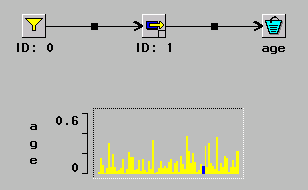Chapter Contents
Previous
Next
|
Chapter Contents |
Previous |
Next |
| Selected Examples |
In this example, shown in Figure 9.9, the model has deterministic arrival rate and nonhomogeneous Poisson service times.

|
The service rate is 9 + cos(0.001t), where t is the value of the simulation time when a sample is taken. This rate function is specified via the control panel for the random variable, as shown in Figure 9.10.

|
In this window you can set two parameters of the process: the rate function and the maximum value that the rate function can take. The rate function is specified as a QSIM formula. When you click the Rate Function button, a Formula Manager window opens and allows you to specify the function.
|
|
Figure 9.11 shows the function used in this example. The maximum is needed by the algorithm that does the sampling. If this is not the correct maximum or the function specified is not cyclical, then the sample is not from the desired distribution.
When the transactions from this simple model are displayed in the LinePlot as shown in Figure 9.9, you can see the impact of the cyclical rate function on the transaction time in the system.
|
Chapter Contents |
Previous |
Next |
Top |
Copyright © 1999 by SAS Institute Inc., Cary, NC, USA. All rights reserved.